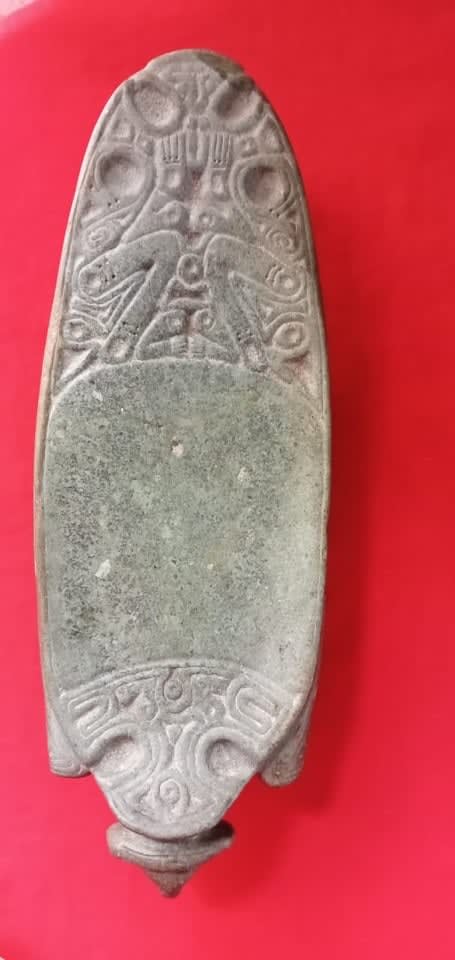Taíno Zemí Cohoba Tray, 1200 CE - 1500 CE
Stone
8 x 41 x 14.5 cm
3 1/8 x 16 1/8 x 5 3/4 in
3 1/8 x 16 1/8 x 5 3/4 in
GM.0050
An exceptional zemí cohoba tray. Zemís constitute some of the most important and remarkable among the artistic expressions of the Taino culture, they were sculptures intended to represent the physical...
An exceptional zemí cohoba tray. Zemís constitute some of the most important and remarkable among the artistic expressions of the Taino culture, they were sculptures intended to represent the physical incarnation of a Taíno god, spirit, or ancestor. These sculptures were most probably used for worship and rituals in the two social classes of the Taíno society: the naborias and the nitaínos. The naborias were the class tasked with manual labour, and were in charge of fishing, hunting, and working in the fields. The nitaínos constituted the nobility of the Taíno society and supervised the work of the naborias. Probably ritual objects were present also in the huts were naborias families resided (though it is probable that ritual objects to be used in houses were made of perishable material such as wood). The beautiful stone objects which survived until this day were probably used by the cacique, the elite of the nitaínos class in charge of government and worship for their centralized magico-religious ritual on a village scale. These rituals were most probably aimed at the preservation of the natural and social order of the Taíno civilisation, and invoked divine aid for the growth of crops, fertility, and other key elements of the daily lives of the people.
This particular artefact was used for the cohoba ritual, a ceremony which consisted in the grinding and inhalation of the seeds of the cojóbana tree (Anadenanthera peregrina) to induce hallucinations. The tray schematically represents a figure on its fours, with the legs and arms constituting the foot of the tray and a representation of the genitals between the legs. The from presents a skeletal face with wide eyes and open mouth without teeth, along with a decoration on top of the head (maybe a schematic representation of hair or of a band or crown) that merges seamlessly with the ears. The edges fo the eyes and the nose emerge powerfully from the skeletal cheeks rendered without flesh. On the immediate back of the head there are geometric decorative motifs, which extend also on the sides and on the bottom, on the bent arms. The top part of the artefact presents a smooth part, where the grinding of the seeds of the cojóbana tree and the inhalation of the resulting powder with an Y-shaped nasal snuff tube would happen. The back of the tray presents a schematic and beautiful bi-dimensional representation of a squatting zemí, remindful of the trigonolito type well attested in Taíno artistic expression. The skeletal mouth with clenched teeth is represented on the edge.
Taíno culture flourished in the Caribbean between AD 1200 – AD 1500. The arrival of the Spanish in AD 1492 resulted in its rapid decline but the ritual objects left by their civilisation testify to high levels of craftsmanship.
This particular artefact was used for the cohoba ritual, a ceremony which consisted in the grinding and inhalation of the seeds of the cojóbana tree (Anadenanthera peregrina) to induce hallucinations. The tray schematically represents a figure on its fours, with the legs and arms constituting the foot of the tray and a representation of the genitals between the legs. The from presents a skeletal face with wide eyes and open mouth without teeth, along with a decoration on top of the head (maybe a schematic representation of hair or of a band or crown) that merges seamlessly with the ears. The edges fo the eyes and the nose emerge powerfully from the skeletal cheeks rendered without flesh. On the immediate back of the head there are geometric decorative motifs, which extend also on the sides and on the bottom, on the bent arms. The top part of the artefact presents a smooth part, where the grinding of the seeds of the cojóbana tree and the inhalation of the resulting powder with an Y-shaped nasal snuff tube would happen. The back of the tray presents a schematic and beautiful bi-dimensional representation of a squatting zemí, remindful of the trigonolito type well attested in Taíno artistic expression. The skeletal mouth with clenched teeth is represented on the edge.
Taíno culture flourished in the Caribbean between AD 1200 – AD 1500. The arrival of the Spanish in AD 1492 resulted in its rapid decline but the ritual objects left by their civilisation testify to high levels of craftsmanship.
